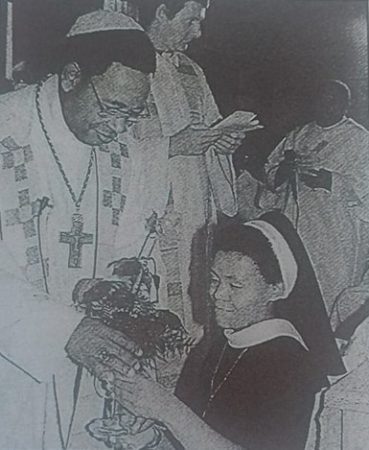In May 1994, the Irish Times published a special supplement on the Sisters of Mercy in the lead up to the Founding Day in July. In this article which was one of the articles published in the supplement, Sr. St. John talks about life in Soweto, before and after the end of apartheid and the church’s role.
Only two years after entering the Novitiate straight from school in Ardagh, Co Limerick, Sr. St. John found herself studying English, History and African Lanugauge – Sutu – in a Johannesburg University. She has lived and taught in the black township of Soweto ever since.
It hasn’t been easy. The Catholic schools in South Africa are the only ones that have always been open to all students, regardless of colour. This they did, she says, under constant threat of deregulation by the South African government.
“What saved us from closure was that the government tried to close the schools down one by one. We banded together and said ‘If one goes, we all go’. They soon realised they couldn’t cope with the sheer volume of pupils they were going to have to deal with”, she says.
At the same time, the South African government was asking Catholic schools ‘indirectly’ to take the children of ambassadors from other African countries. “We fought them on the basis that if our schools were to be open to them, they should be open to all.”
Sr. St. John credits that battle as the first step on the road to the current enlightenment in South Africa. “It was certainly the first act of institutional defiance the government had to face.”
Now, some years later, the Sisters are able to look beyond its schools. The congregation runs adult education centres, health care clinics, homes for drug and alcohol abusers and is setting up night shelters for the homeless.
“At times housing and homelessness, in particular, seem like too big a problem for us to do anything about. But then you remember that some of the people now living in corrugated iron shacks were previously living in tents. So there has been some progress already.”
She is proud that Soweto has been the seat of resistance for black South Africa. But she believes it is a community that has turned a corner, away from the television images of violence and reprisal.
Identifying herself as very much a part of that community, she says, “We have a great sense of anticipation at the moment. The feeling is that freedom has come. It’s a happy place to be now.”
“You can see it most clearly in the young people, who are at last free to concentrate on their studies. Even up to last year, they were all too involved in the struggle to do this.”
In effect, this meant that all boycotts and freedom days were observed, rallies and marches were attended – and a lot of classrooms were left empty.
Not that Sr. St. John is complaining. “All these actions were important shows of defiance, and the children did what they had to do. The result now is that they have a real sense of having achieved freedom for and by themselves. It has given them great pride.”
That the Sisters of Mercy are associated with that pride is witnessed by the growing number of black South African women joining the congregation.
“The main charisma of the congregation is ‘Mercy’, and that strikes a chord with the people. They see us caring for the homeless, the sick and the hungry and visiting the imprisoned. It strikes a chord with some part of their own culture. They like and want to be associated with it,” she explains.
“I really feel very optimistic for South Africa, based on the amount of prayer and goodwill that’s out there alone. Prayer has accompanied the freedom movement all the way, and there is a feeling that God has answered their prayers.”
 Sr. Constance Khuele becomes the first Sowetan to take her vows and join the Sisters of Mercy
Sr. Constance Khuele becomes the first Sowetan to take her vows and join the Sisters of Mercy
But how does she, a member of a religious congregation, reconcile that freedom movement with the violence that accompanied it? “Some years ago, we used to visit the young people in hospital on hunger strike. And I felt that if they were able to reconcile both their struggle and their faith, then why couldn’t I?”
She draws an analogy of her position, using a well-known church in the area. “The Regina Mundi is the largest church in Soweto. When things got really bad, the late Archbishop Fitzgerald of Johannesburg issued a direction that it must never be refused to any political group who needed it, and so it became a meeting place for many, many rallies.” So many that it was firebombed by white extremists.
Allowing the church to be used in this way was a very significant move on the Church’s part, according to Sr. St. John, because, when meetings were banned, the people couldn’t legally congregate anywhere but in a church. “But the really important thing was that the people knew that the Church was with them in their struggle.”
This article was written by Sandra O’Connell and was printed in the Irish Times Sisters of Mercy Special Report on Wednesday 18th May, 1994.


